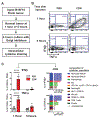TNFα and Radioresistant Stromal Cells Are Essential for Therapeutic Efficacy of Cyclic Dinucleotide STING Agonists in Nonimmunogenic Tumors
- PMID: 29472271
- PMCID: PMC6215542
- DOI: 10.1158/2326-6066.CIR-17-0263
TNFα and Radioresistant Stromal Cells Are Essential for Therapeutic Efficacy of Cyclic Dinucleotide STING Agonists in Nonimmunogenic Tumors
Abstract
The cGAS-STING cytosolic DNA sensing pathway may play an integral role in the initiation of antitumor immune responses. Studies evaluating the immunogenicity of various cyclic dinucleotide (CDN) STING agonists administered by intratumoral (i.t.) injection showed potent induction of inflammation, tumor necrosis, and, in some cases, durable tumor-specific adaptive immunity. However, the specific immune mechanisms underlying these responses remain incompletely defined. The majority of these studies have focused on the effect of CDNs on immune cells but have not conclusively interrogated the role of stromal cells in the acute rejection of the CDN-injected tumor. Here, we revealed a mechanism of STING agonist-mediated tumor response that relied on both stromal and immune cells to achieve tumor regression and clearance. Using knockout and bone marrow chimeric mice, we showed that although bone marrow-derived TNFα was necessary for CDN-induced necrosis, STING signaling in radioresistant stromal cells was also essential for CDN-mediated tumor rejection. These results provide evidence for crosstalk between stromal and hematopoietic cells during CDN-mediated tumor collapse after i.t. administration. These mechanistic insights may prove critical in the clinical development of STING agonists. Cancer Immunol Res; 6(4); 422-33. ©2018 AACR.
©2018 American Association for Cancer Research.
Conflict of interest statement
Disclosure of Potential Conflicts of Interest
A.L. Desbien is a scientist at Aduro Biotech and reports receiving a commercial research grant from the same. K.E. Sivick has ownership interest in a patent with Aduro Biotech. C.G. Drake reports receiving a commercial research grant from Aduro Biotech. No potential conflicts of interest were disclosed by the other authors.
Figures







Similar articles
-
Direct Activation of STING in the Tumor Microenvironment Leads to Potent and Systemic Tumor Regression and Immunity.Cell Rep. 2015 May 19;11(7):1018-30. doi: 10.1016/j.celrep.2015.04.031. Epub 2015 May 7. Cell Rep. 2015. PMID: 25959818 Free PMC article.
-
STING-Dependent Cytosolic DNA Sensing Promotes Radiation-Induced Type I Interferon-Dependent Antitumor Immunity in Immunogenic Tumors.Immunity. 2014 Nov 20;41(5):843-52. doi: 10.1016/j.immuni.2014.10.019. Epub 2014 Nov 6. Immunity. 2014. PMID: 25517616 Free PMC article.
-
Refractoriness of STING therapy is relieved by AKT inhibitor through effective vascular disruption in tumour.Nat Commun. 2021 Jul 20;12(1):4405. doi: 10.1038/s41467-021-24603-w. Nat Commun. 2021. PMID: 34285232 Free PMC article.
-
Novel Modifications and Delivery Modes of Cyclic Dinucleotides for STING Activation in Cancer Treatment.Int J Nanomedicine. 2025 Jan 6;20:181-197. doi: 10.2147/IJN.S503780. eCollection 2025. Int J Nanomedicine. 2025. PMID: 39802380 Free PMC article. Review.
-
STING Activation and its Application in Immuno-Oncology.Curr Top Med Chem. 2019;19(24):2205-2227. doi: 10.2174/1568026619666191010155903. Curr Top Med Chem. 2019. PMID: 31642767 Review.
Cited by
-
Intratumoral STING agonist reverses immune evasion in PD-(L)1-refractory Merkel cell carcinoma: mechanistic insights from detailed biomarker analyses.J Immunother Cancer. 2024 Oct 14;12(10):e009803. doi: 10.1136/jitc-2024-009803. J Immunother Cancer. 2024. PMID: 39401968 Free PMC article.
-
STING Agonists as Cancer Therapeutics.Cancers (Basel). 2021 May 30;13(11):2695. doi: 10.3390/cancers13112695. Cancers (Basel). 2021. PMID: 34070756 Free PMC article. Review.
-
Activation of cGAS-STING pathway - A possible cause of myofiber atrophy/necrosis in dermatomyositis and immune-mediated necrotizing myopathy.J Clin Lab Anal. 2022 Oct;36(10):e24631. doi: 10.1002/jcla.24631. Epub 2022 Aug 28. J Clin Lab Anal. 2022. PMID: 36030554 Free PMC article.
-
Synergy of a STING agonist and an IL-2 superkine in cancer immunotherapy against MHC I-deficient and MHC I+ tumors.Proc Natl Acad Sci U S A. 2022 May 31;119(22):e2200568119. doi: 10.1073/pnas.2200568119. Epub 2022 May 19. Proc Natl Acad Sci U S A. 2022. PMID: 35588144 Free PMC article.
-
The Age of Cyclic Dinucleotide Vaccine Adjuvants.Vaccines (Basel). 2020 Aug 13;8(3):453. doi: 10.3390/vaccines8030453. Vaccines (Basel). 2020. PMID: 32823563 Free PMC article. Review.
References
-
- Hayashi F, Smith KD, Ozinsky A, Hawn TR, Yi EC, Goodlett DR, et al. The innate immune response to bacterial flagellin is mediated by Toll-like receptor 5. Nature 2001;410:1099–103. - PubMed
-
- Hoshino K, Takeuchi O, Kawai T, Sanjo H, Ogawa T, Takeda Y, et al. Cutting edge: Toll-like receptor 4 (TLR4)-deficient mice are hyporesponsive to lipopolysaccharide: Evidence for TLR4 as the Lps gene product. J Immunol 1999;162:3749–52. - PubMed
-
- O’Neill LA, Golenbock D, Bowie AG. The history of Toll-like receptors redefining innate immunity. Nat Rev Immunol 2013;13:453–60. - PubMed
-
- Akira S, Takeda K. Toll-like receptor signalling. Nat Rev Immunol 2004;4:499–511. - PubMed
Publication types
MeSH terms
Substances
Grants and funding
LinkOut - more resources
Full Text Sources
Other Literature Sources
Molecular Biology Databases
Research Materials

